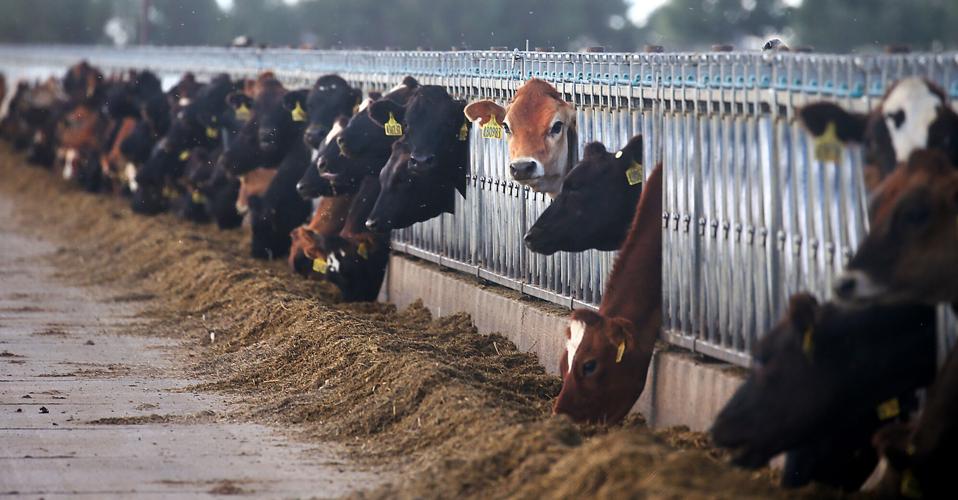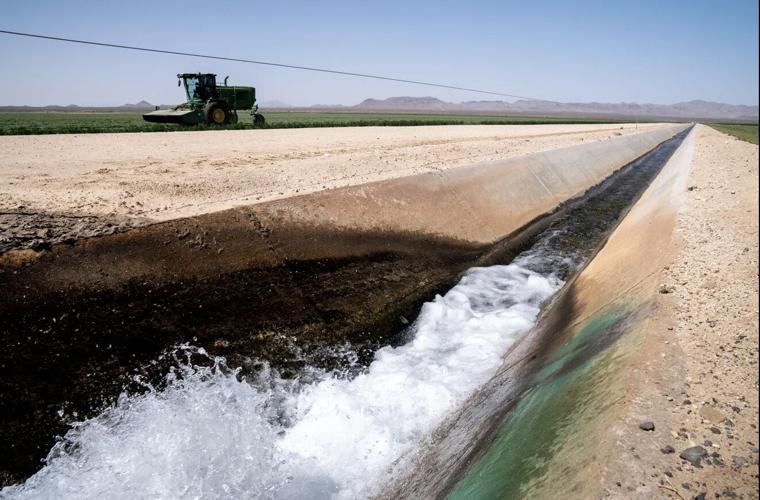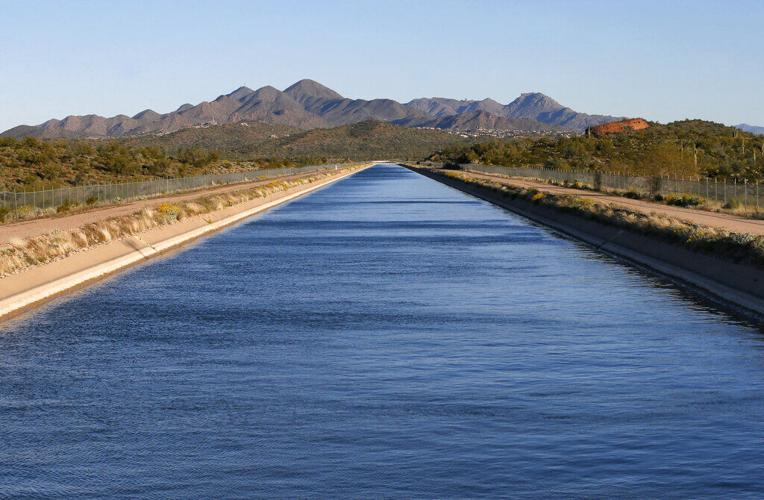Cattle raised for beef and dairy products are taking by far the largest share of Colorado River’s dwindling water supply, a new study found.
Whether it’s in the form of hamburger, steak, veal, cheese, yogurt or milk, many of us love to consume byproducts of the cow.
Because of that, cattle feed, including alfalfa and other forms of hay, accounted for 46% of all water directly diverted from the river by humans. The cattle feed represented 32% of all river water taken from the Colorado, when evaporation in reservoirs and natural use by riverfront trees and shrubs are included, said the new study, written by 12 researchers.
Other findings:
— Arizona had the smallest share of alfalfa and hay acreage of any Western state but alfalfa fields here used more water per acre than in any other Western state.
— All irrigated crops account for 74% of river water deliberately taken by people and 52% of all river water used. Indirect uses include evaporation and riparian vegetation.
— Cattle feed crops account for 62% of all farm water use in the entire river basin — including 90% of farm water use in the river’s Upper Basin states of Colorado, New Mexico, Utah and Wyoming.
— Residential, commercial and industrial use accounted for about 25% of the river’s supply taken directly by people and 18% of the total river water use.
— In the Lower Basin states of Arizona, California and Nevada, farms took 72% and cities took 28% of all directly used river water. Alfalfa and other forms of hay accounted for 41% of such water use.
— Riparian and wetland plants account for about 19% of all river water used, said the study, published in the journal Communications Earth and Environment. Another 11% of the river’s total supply is lost to evaporation.
“Either way that you cut it, irrigated agriculture is consuming 3 times more than commercial and industrial uses and municipal uses. The cattle feed crops are consuming one-third of all river water, and two-thirds of all water used by irrigated agriculture,” said Brian Richter, the study’s lead author.
The study was the first Richter knows of to try to provide a blow-by-blow breakdown of how much water various sectors of the economy are using, as well as nature and evaporation, said Richter, president of the national conservation group Sustainable Waters, and a senior fellow for the World Wildlife Fund.
“The primary motivation for doing this was that we really wanted to get the whole picture of where all of the river’s water goes,” he said.

Swathers cut alfalfa at a farm in Arizona’s La Paz County. Cattle feed crops, including alfalfa, are consuming one-third of all Colorado River water, and two-thirds of all the river’s water that’s used by irrigated agriculture, a new study finds.
Figures Richter’s team gathered for the study, using satellite imagery, showed alfalfa is grown on 212,000 acres in Arizona. That makes it the second most commonly grown crop in this state after cotton, at about 293,000 acres.
Arizona’s total alfalfa acreage was lowest among the seven river basin states and the surrounding Western states outside the river basin, with California’s 931,000 acres leading the pack.
But because of Arizona’s extremely dry heat from May through September, farmers in this state used by far more water per acre of alfalfa grown — 5.7 acre-feet — than any other Western state. Cotton, long derided by critics as another thirsty crop, used less than half that much water per acre in Arizona — 2.7 acre-feet.
“It can take more than twice as much water to grow alfalfa in the Imperial Irrigation District or in Yuma than it does in Colorado or Wyoming,” said Richter, speaking of the irrigation district based in the Southern California desert west of El Centro.
“That’s because it’s much hotter in the southern areas of the basin — which greatly increases evapotranspiration from crops — and because they are able to get more cuttings (of alfalfa crop) per year in the southern areas.”
But because alfalfa crop yields are higher in the warmer Lower Colorado River Basin than elsewhere in the West, the difference in our basin’s water use per ton of alfalfa grown compared to other regions isn’t as great as the differences in water use per acre of alfalfa grown, U.S. Department of Agriculture data shows. That information was supplied to the Star by University of Arizona professor George Frisvold, an agricultural economist.
The study comes as negotiators for the seven river basin states and the federal government are going to be spending up to the next three years hashing out a new agreement to manage the Colorado River and its reservoirs.
For now, the basin states, 30 tribes, the U.S. government and Mexico are deadlocked over how much water each entity will have to give up as the states and federal government rewrite the basic operating rules of the river to replace existing rules that expire at the close of 2026.
The expected cuts need to be enough to prevent the river’s main reservoirs, Lake Powell and Lake Mead, from falling to catastrophically low levels — elevations so low that the reservoirs won’t be able to generate electricity any longer. Authorities also hope to keep the reservoirs from falling even lower, to “dead pool” levels at which no more water can be pulled from them at all.
An earlier study in which Richter was involved found that municipal water use, basin-wide, has been cut by 18% since 2000, through various conservation programs, even as the states’ population grew 24%, he said.
Water use by farms has dropped 15% since 2000 in the river’s Lower Basin states of Arizona, Nevada and California, but risen 5% in the Upper Bain states, the new study found.
“Cities are doing a miraculous job of cutting water use. We need a commensurate reduction by farms,” Richter said.
But it’s “absolutely” not the researchers’ intention to bash farmers and ranchers’ water use, said Richter, who with other researchers has published numerous studies on farm water use in recent years.
“The farmers and ranchers are growing what people want and are willing to pay for. But at the same time, we wanted to put out a factual information base, so negotiators and the general public understand how the water is being used presently,” Richter said.
Also, while cattle grazing on public land have long been a major target for many environmentalists, Richter noted that the cattle feed is grown mostly on private land — not on public land pastures.
He hopes this study’s results will help inspire states and the federal government to affirm the total amount of water that can be sustainably used for human consumption. Currently, he estimates that cities and farms are overdrafting the river’s total supply by about 20%.
“Once you set that as a cap, it starts to stimulate long-term investments” in infrastructure, he said. “We’re going to have to live under nature’s limits, so how are we going to do that?”
Until now, the states have operated in what Richter calls a “short-term response mode. Every year, we’re watching to see how much water comes down the river, and that determines how much of a cutback the lower basin has to make. Nobody can ever plan much in advance. That’s not conducive to long-term investments in the future.”
The proposed water reduction plans from the Lower and Upper Basins continue in that reactive vein, by calling for curtailment of river water deliveries based on reservoir levels across the river system, he said.
“If you’re always focused on how to react to this year’s water shortages, you’re not spending enough time planning on what needs to be done to secure our water future,’ Richter said. “To prove the point, I am unaware of any plan that lays out how cities, industries, and farms will need to change to bring the river’s water budget back into balance, and how to sustain a balance as climate change diminishes water flows in the future.”
Overall, the study estimated that about 19.2 million acre-feet a year of water total is taken from the Colorado by all users. By comparison, the Central Arizona Project canal system has pulled about 1 million acre-feet a year from the river in most recent years for delivery to the Tucson and Phoenix areas for drinking water.
Evaporation has cost the river about 2 million acre-feet of water yearly, the study found.
The cottonwoods, willow, mesquite and other trees and shrubs lining the river banks were found to use about 3.6 million acre-feet a year.
The researchers did not intend to portray riparian use as a drain on river water, but decided to discuss it because “it gives us a fuller perspective of all the benefits the Colorado River provides,” Richter said.

The Central Arizona Project canal carries Colorado River water to farms and to Phoenix and Tucson. “Cities are doing a miraculous job of cutting water use. We need a commensurate reduction by farms,” says researcher Brian Richter.
“That 19% going to native vegetation is really important for our recreational enjoyment: hunting, fishing, aesthetic beauty and wildlife viewing. It’s important to us to bring that into the discussion of how the river benefits us,” Richter said. “We’re bringing nature into the water budget.”
Also, the new study calculated that 1.78 million acre-feet are used in the Gila River Basin. Its rivers, including the San Pedro, the Santa Cruz, the Gila and the Salt, are tributaries to the Colorado.
Since the Gila Basin’s use accounts for almost one-fourth of the entire Lower Basin’s use, “it makes sense to look at all of the water use in entirety of the Colorado River,” said Richter.
Today, the Upper and Lower Basin states are locked in conflict over the Upper Basin’s claim that the Gila tributaries’ use should be counted toward the Lower Basin’s total river water allocation.
But “I’m not going to weigh in on that,” Richter said. “I’m going to take the fifth.”
Behind the series: The Star's longtime environmental reporter Tony Davis shares what inspired him to write the investigative series "Colorado River reckoning: Not enough water."






